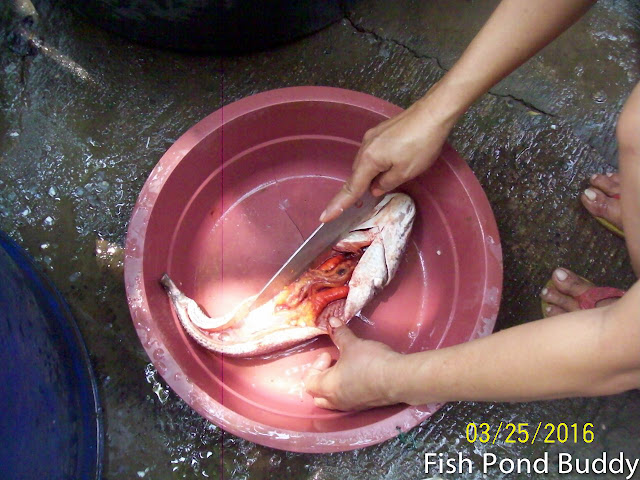How to Catch and Clean a School of Mudfish Fry
(Pls. click this to see related post on Fish Farmer vs. Mudfish ("Dalag"))
Recently, we were touring one of our ponds where tilapia are grown to market size. Two of my veteran pond workers, part of the harvest crew, were visiting at the time and joined us.
Luckily for me, they noticed a reddish orange patch-like mass in the middle of the pond that seemed to be moving. Rushing to get a closer look, they pointed to us the thousands of baby mudfish ("bulig" in Tagalog) swimming together near the surface.
 |
| A school of dalag fry swimming on surface; red orangish color faintly visible from afar |
It was the first time I’ve seen such a bunch of tiny mudfish fry. They move together as a group at the surface in synch (same pace and direction). When approached, they all turned abruptly at the same time and moved away (as if under threat). The group has a distinct red-orange hue which can be viewed from afar. From a closer view, the red-orange color contrasts starkly with the greenish hue of pond water.
 |
| School of baby dalag more visible as they approach the side of the pond |
Alerted by the presence of tiny young fry (which are potential deadly predators of our bangus and prawns), I quickly asked my workers to catch the entire shoal using our large sorting net (“saplar”). Also, rushed to get my camera to take some photos.
So, here’s how to catch and clean a school of young mudfish fry (“bulig”) in Tagalog.
Catching a Bunch of Young Mudfish Fry
1. Get a large sorting net (“saplar”)(see blue green net in photo below).
2. Go down the pond with the net near where the shoal is swimming (it takes two persons to do the catching). Note: the dalag fry swim slowly as a group so it does not take much to snare them.
 |
| Using a sorting net ("saplar") to catch the bunch of dalag fry |
3. Insert one part of the net under water with the school of fish in the middle.
4. Pull the sorting net up while enclosing the school of fish; raise the net to prevent escape of fish.
5. Pull the net up and transfer the bunch of tiny fry in a plastic pail.
 |
| Transferring fry from net to plastic pail |
6. Remove grass, dirt, and other debris from the pail.
 |
| Removing grass, leaves and other debris from pail |
 |
| A handful of young dalag fry scooped out of the pail |
 |
| Newly caught bunch of dalag fry in a pail |
Cleaning the Bunch of Fry
7. Transfer the fish from the pail to a strainer. Pour water into the strainer. Let drip.
 |
| Dalag fry in strainer after pouring water; removing remaining debris |
8. Transfer the fish from the strainer to a small plastic basin.
9. Sprinkle the fish with salt and mash the pile of fish to mix the salt evenly.
 |
| Mashing the pile of fish with salt; see bottle of salt (upper right) |
 |
| More salt added before mashing; salt aids in removing mucus and slime from the pile of fry |
10. Using a piece of fine abaca net, rub the net against the fry and mash the pile of fish with it. This will allow the net to take out the mucus, slime, tiny scales off the fry. Wash the abaca net clean to be used again.
 |
| Scrubbing and mashing the pile of dalag fry using fine abaca net to remove mucus and tiny scales |
11. Transfer the batch to the strainer, pour water and let drip.
12. Repeat Steps 7 to 11 three times until the bunch of fry is mucus-free and whitish in color. Set aside in another clean plastic basin.
This batch of cleaned dalag fry is now ready as main ingredient for cooking the local fish omelet or fish torta filipino. This is a mix of dalag fry with flour, salt, eggs, pepper, chopped garlic, chopped onion, a pinch of Magic Sarap seasoning (a popular local brand of flavor enhancer), Worcestershire sauce, and bit of water. Then shape the mix into patties and fry them into a crisp golden brown filipino fish omelet!
Eat with newly cooked rice. Or put in a bun, with sliced tomato, onion rings, and lettuce - and you have a delicious fish burger!
For the procedure on how to clean the adult mudfish ("dalag"), pls. click this for the related post.
For a complete lists of Fish Pond Buddy blog posts on fish farm-related topics, please click the Index page.

















































